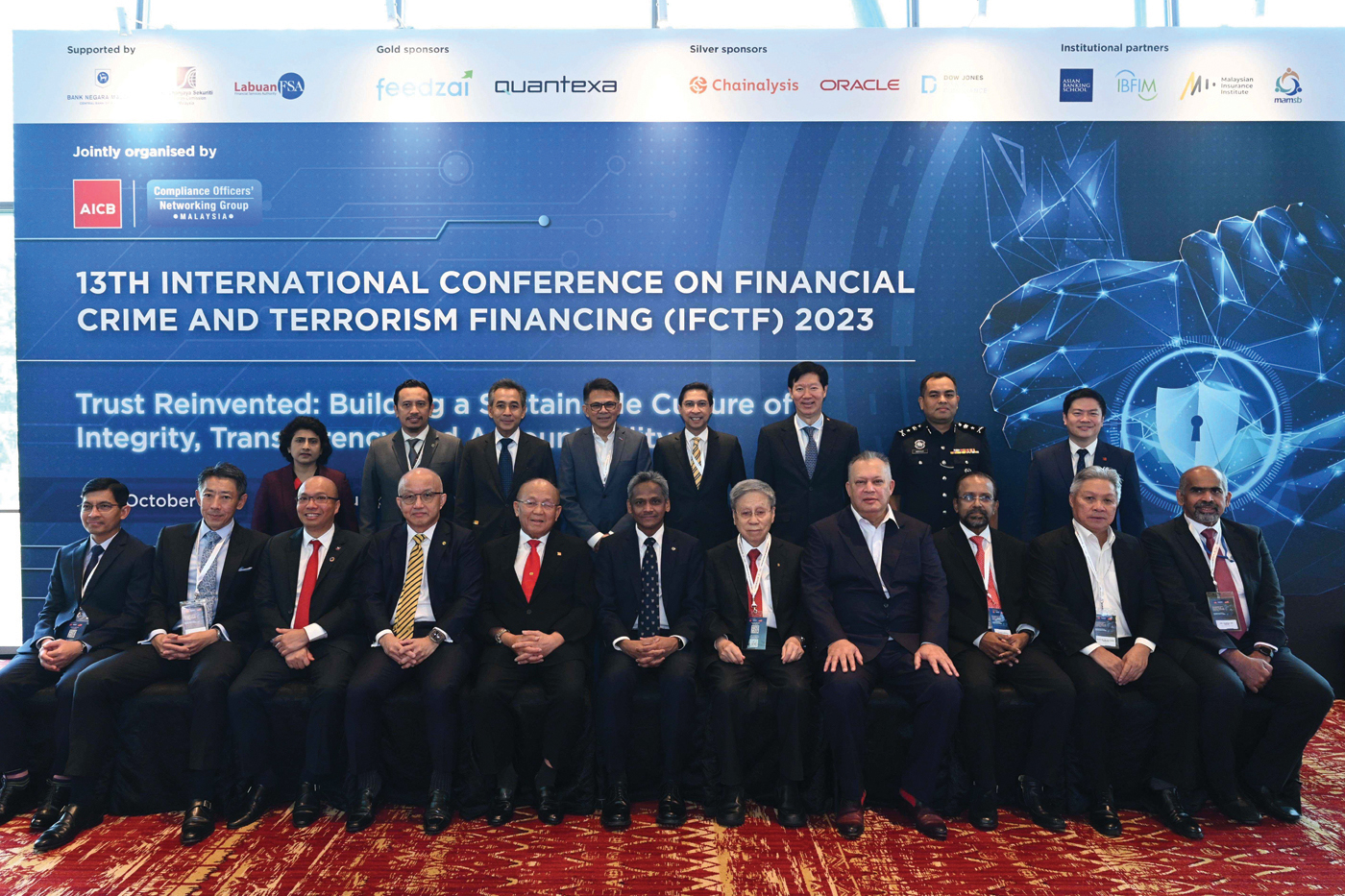Trust Reinvented
True to the theme of Trust Reinvented: Building a Sustainable Culture of Integrity, Transparency and Accountability, the AICB’s 13th International Conference on Financial Crime and Terrorism Financing (IFCTF) held at the Kuala Lumpur Convention Centre from 2 to 4 October 2023 drew close to 1,300 delegates with over 50 speakers representing the diverse perspectives of each continent.

Organised by the Institute and its Compliance Officers’ Networking Group, with the support of Bank Negara Malaysia, Securities Commission Malaysia, and Labuan Financial Services Authority, global and regional experts explored the evolutionary nature of trust and how banking must reshape its defences to counter the emergence of new threat actors in the digital space and account for new priorities such as environmental crime.
Tan Sri Azman Hashim, FCB, Chairman of AICB, conveyed the essence of the conference in his welcome remarks: “Trust reinvention is the beacon of hope that guides us towards a sustainable, stable and secure nation. In combatting financial crime and terrorism financing, trust is the bedrock upon which our defence relies. By nurturing a culture of integrity, transparency, and accountability, we not only protect our financial systems but also safeguard our nation and its people from threats that seek to undermine its stability and growth.”
In his opening address, Datuk Abdul Rasheed Ghaffour, FCB, Governor of BNM, made this clarion call to delegates: ”Looking back, though we have covered many miles, many more remain ahead of us. Let us remember that we are running a marathon and not a sprint, and that everything we do is not just for ourselves here today, but also dedicated to the future of Malaysia – a Malaysia renowned for its integrity, seen for its transparency, and committed to accountability.”
Closing In on Crypto Disclosures
On 17 October 2023, the Basel Committee on Banking Supervision (BCBS) issued a consultative document proposing a standardised format and set of templates for banks to disclose their cryptoasset exposures as a further step towards the exercise of “market discipline and contribute to reducing information asymmetry amongst banks and market participants.”
With a proposed implementation date of 1 January 2025, the move is an extension of the BCBS’ prior paper, Prudential Treatment of Cryptoasset Exposures, which outlines the prudential requirements for banks’ exposures in this asset class. The template forms part of a new chapter, DIS55 – Cryptoasset Exposures, in the Basel Framework, and will be subject to the overarching requirements of DIS10 – Disclosure Requirements such as scope of application; reporting location; frequency and timing of disclosure; and assurance of Pillar 3 data.
For more in-depth analysis, read our previous cover story, Crypto’s ‘Whoa Nelly!’ Moment: Basel is Cracking the Whip with its New Global Standard, in the January 2023 edition of Banking Insight.

Project Mandala Takes Off

On 5 October 2023, Bank Negara Malaysia (BNM) announced a regional proof-of-concept to ease the burdens of policy and regulatory compliance for financial institutions. Called Project Mandala, it is spearheaded by the Bank for International Settlements Innovation Hub Singapore Centre together with central bank partners BNM, Royal Bank of Australia, Bank of Korea, and Monetary Authority of Singapore, with the collaboration of financial institutions.
Dr Norhana Endut, BNM Assistant Governor, said, “BNM is committed to making cross-border payments more efficient. Project Mandala could pave the way for more seamless cross-border transactions in the future while ensuring that regulatory compliance and transaction security are maintained. We welcome its potential, not only for Malaysia but also for the global community.”
The project explores the feasibility of encoding jurisdiction-specific policy and regulatory requirements into a common protocol for cross-border use cases such as foreign direct investment, borrowing and payments. Given the diverse range of policy and regulatory frameworks on cross-border payments between jurisdictions, the chief objective is to reduce turnaround time for cross-border transactions.
This is achieved through the:
- automation of compliance procedures;
- provision of real-time transaction monitoring; and
- increase of transparency and visibility around country-specific policies.
Project Mandala aligns with the Financial Stability Board’s 2023 priority actions for achieving the G20 targets for enhancing cross-border payments through a more efficient legal, regulatory, and supervisory environment throughout the payment value chain with no compromise to the safety, security, and integrity of the payments.
The central bank expounded that the envisioned compliance-by-design architecture could enable a more efficient cross-border transfer of any digital assets, including central bank digital currencies and tokenised deposits, serving as the foundational compliance layer for legacy and nascent wholesale or retail payment systems. The measures could include quantifiable and configurable foreign exchange rules, as well as anti-money laundering and countering the financing of terrorism.
Put a Price to It
In a paper released earlier this year, authors Dr Chris Kenyon, global head of quant innovation at MUFG Securities EMEA plc and honorary associate professor at University College London (UCL); Dr Andrea Macrina, Prof of Mathematics at UCL; and Mourad Berrahoui, head of counterparty credit risk modelling at Lloyds Banking Group, introduced a methodology for banks to put a numerical value to its Scope 3 emissions.
Also known as value chain emissions, Scope 3 is defined by the US Environmental Protection Agency “as indirect emissions that occur in the upstream and downstream activities of an organisation” and is estimated to account for more than 70% of the carbon footprint of a business.
The proposed framework, named CO2-equivalent valuation adjustment or CO2eVA by the authors, is proposed as a way for banks to steer their portfolios towards net zero by costing for Scope 3 emissions.

The examples show that the CO2eVA incentives are suitable for portfolio steering because they are significant, and precisely aligned with the CO2-equivalent (CO2e) emission (sequestration) that is enabled via the counterparty balance sheet.
Here’s how the authors describe the essence of their proposed pricing methodology:
“Incentives are required for banks to reach carbon net-zero by 2050 on their portfolios. Here we provide an incentive method where trading with a CO2e emitter (sequestrator) incurs a cost-benefit to the trading desk equal to the mitigation cost of the relevant share of the counterparty emissions (sequestration), illustrating the Carbon Equivalence Principle in use. The CO2eVA may be used in deal return-on-capital calculations in order to steer the bank portfolio towards carbon net zero.
“The examples show that the CO2eVA incentives are suitable for portfolio steering because they are significant, and precisely aligned with the CO2e emission (sequestration) that is enabled via the counterparty balance sheet.”
‘A World Free of Poverty – On a Liveable Planet’
With these words, the World Bank Group’s new President, Ajay Banga, unveiled a new vision and roadmap for the organisation on 13 October at the World Bank-IMF Annual Meetings in Marrakech.

Following Banga’s unequivocal message that the path to “finance a different world“ needs “the scale, resources, and ingenuity of the private sector“, the bank’s website carried this update to indicate how it should lead through example:
“We must find a way to finance a different world where our climate is protected, pandemics are manageable – if not preventable – food is abundant, and fragility and poverty are defeated.
“This journey began in April, when the World Bank and its team found a way to squeeze USD40 billion over 10 years from our balance sheet by adjusting our loan-to-equity ratio. We’ve created a portfolio guarantee mechanism. We’ve launched a hybrid capital instrument. These new tools enable us to take more risks and could help us provide USD157 billion-plus in lending capacity over a decade.
“We need donors, shareholders, and philanthropies to join us and bring their ambition to this fight, otherwise these instruments are just theoretical.”